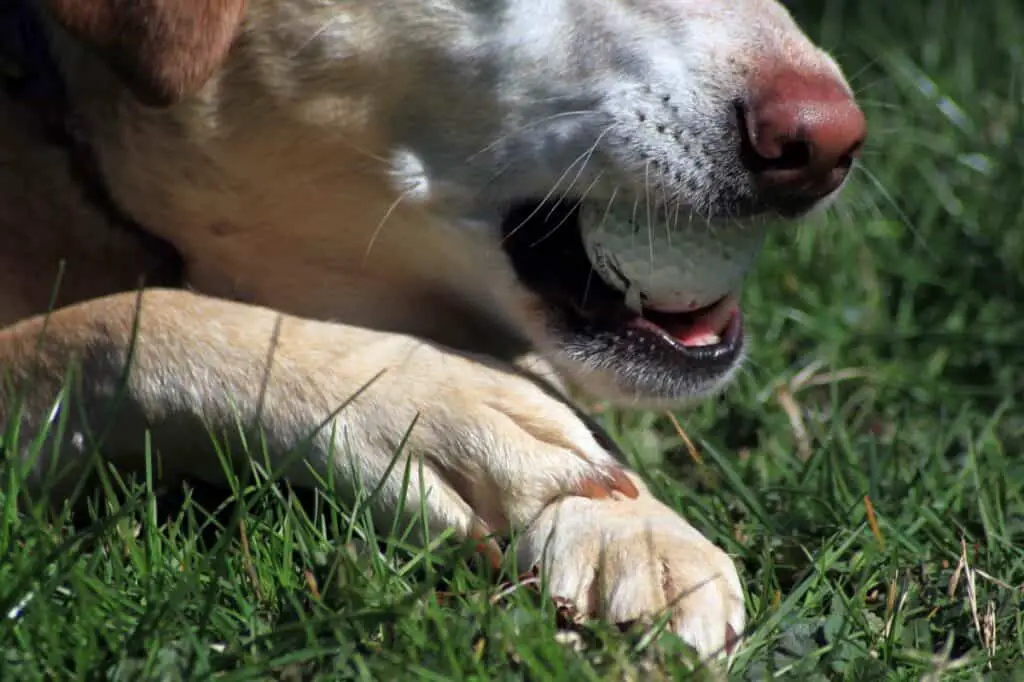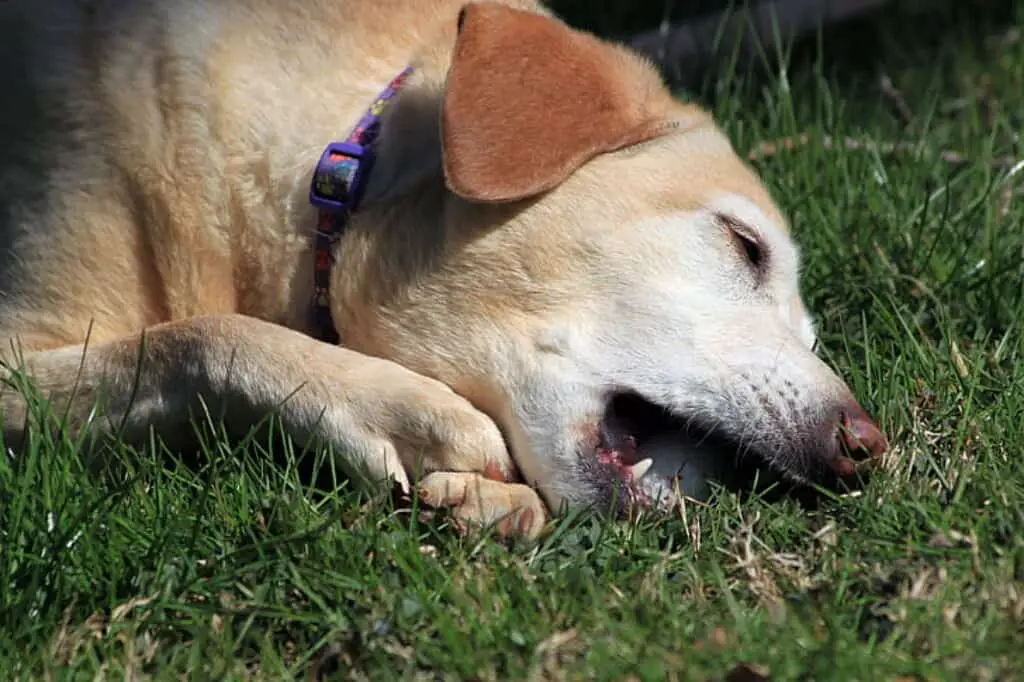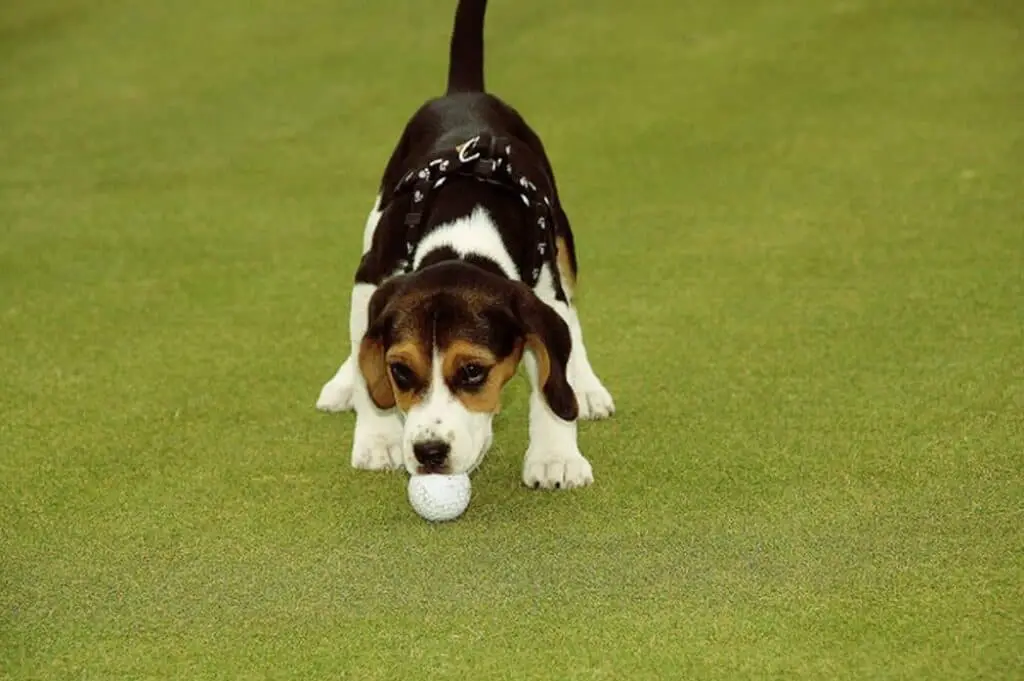Are Golf Balls Safe for Dogs? (Solved)
Everyone who’s ever owned a dog knows how much they like to run after anything you throw at them, be it a stick, a ball, or a toy.
There’s hardly anything else that brings that much joy to dogs as playing fetch, especially if they get a chance to chase a ball.
Besides chasing after them, they also like to play with and chew on balls, which is where the seemingly carefree and innocent game can get problematic.
The fact is, not all types of balls are safe for your furry, four-legged friends.
For example, if you’re a golfer, you may be wondering are golf balls safe for dogs.
You probably have some balls just lying around or you may even use them to play with your dog.
Below, I’ll explain if this is a smart thing to do and if golf balls can pose any danger to dogs.
So, let’s dive in!
Table of Contents
Are Golf Balls Safe for Dogs?
The answer to the question “are golf balls safe for dogs” will depend on several factors, but in general, a golf ball can be very dangerous for dogs.
So, it’s best to stay on the safe side and find your dog something else to play with.
You’ve probably seen videos of dogs playing with golf balls or even witnessed it at the park, with no harm coming to them.
However, this doesn’t mean that there’s no danger involved, especially for medium-sized and larger dogs who can easily swallow the golf ball.
Just chasing the ball or rolling it around with their legs would not pose any danger to the dog, but you can’t really rely on them not to pick it up with their mouth or try to chew it.
And, when this happens, there are several potential risks that can lead to more or less serious harm to your dog.
Choking Hazard

Probably the biggest concern you should have if your dog is playing with a golf ball is the possibility of choking.
While the danger is certainly greater the larger the dog is, this doesn’t mean that the smaller breeds are not at risk.
The risk is particularly high when playing fetch, as the dog will chase the ball and try to catch it in the air or while it’s still moving.
When they’re jumping or running at a full speed with their mouths wide open, the ball can easily wedge in their throat and get stuck there.
Even when the ball doesn’t go to the throat immediately, it will become slimy and can easily slide and lodge in the dog’s throat.
When the ball doesn’t get stuck in the windpipe, a dog may accidentally swallow it which brings a whole new set of problems and most likely a surgical procedure.
How to Tell that your Dog is Choking on a Golf Ball
In the unfortunate event of your dog choking on a golf ball, it’s of the utmost importance to react as quickly as possible as that can save his life.
However, as you may not see the dog swallowing the ball, it’s essential that you learn some of the signs that indicate that the dog may be choking.
The first and the most obvious sign is coughing, as the dog will instinctively try to expel the ball stuck in its throat.
I may also pay its head or mouth and start behaving all panicky, a logical reaction to not being able to breathe.
As it struggles to breathe, the dog may also start to drool, gag, and even vomit.
If the situation takes a while, a dog may lose its consciousness due to the inability to breathe and the lack of oxygen.
What to Do When Your Dog is Choking on a Golf Ball
When you notice some of the signs described above, you should react immediately and try to help your dog.
If you establish that the ball is blocking the dog’s throat, swipe your fingers sideways against it to try to expel it.
If this doesn’t work, you may try the Heimlich Maneuver.
For smaller dogs, place them on their back and press palms upwards from the ribcage towards the sternum. Repeat this five times.
In the case of a larger breed, stand him upright on two legs, as you would do with a human.
Then put your arms around the dog and join them at the abdomen forming a fist. Then, thrust forwards and upwards five times to try to dislodge the ball.
If you can’t manage to expel the ball with any of these methods, get the dog to the vet as quickly as you can.
Risk of Chemical Materials and Toxins

Golf balls, as you probably know, are mostly made of plastic and rubber materials, and each of those can be harmful to dogs’ health.
Prolonged exposure to chemicals such as surlyn (a thermoplastic resin) or urethane, found in golf ball coating, can be harmful to the dog if it swallows the ball.
In the case of chewing the ball, and managing to peel out the ball’s coat, the effect will be even more severe.
The golf ball core may contain several harmful chemicals, such as polybutadiene, zinc acrylate, or zinc oxide.
Each of these is known to cause dangerous allergic reactions in dogs.
These can be particularly risky when instant aid is not available, which is commonly the case.
The reaction to these chemicals may include vomiting, refusal to eat or drink, or becoming noticeably lethargic.
If you notice any of these symptoms, immediately take your dog to the vet.
Chipped Pieces of the Golf Ball
Dogs love to gnaw on their favorite toys and if that toy is a golf ball, they can easily chip off small pieces.
These pieces, made of plastic, can be very harmful to the dog’s system. While they’re not likely to be life-threatening, these pieces can still do a lot of damage.
The best-case scenario is that they can be somewhat painful and make the dog uncomfortable.
At worst, pieces of plastic can pierce the dog’s intestine or esophagus. Larger pieces can lodge in the intestines and cause blockage, or even serious infections.
Dental Damage
Another potential risk of allowing your dog to play with golf balls is the damage to their teeth.
While the common wisdom is that chewing makes the dog’s teeth stronger, this is not the case when it comes to gnawing on golf balls.
Among other ingredients, golf ball typically contains fiberglass, which has a similar structure to sandpaper.
Obviously, this may cause severe damage to a dog’s teeth, no matter its age or size.
Also, you should be aware that golf balls are commonly much harder than other types of dog toys.
So, as they’re used to softer toys, dogs may bite at golf balls too hard and break or chip their teeth, especially when trying to catch it mid-air.
Plus, the pieces of the ball may lodge into the gums and cause inflammation or infection.
All this may require dental surgery, which is something you should definitely try to avoid.
Keeping Your Dog Away from the Golf Balls

As you can, see golf balls and dogs are not a match made in heaven, so you should always look to keep your golf balls away from your dog.
Being careful about this is the best prevention for some of the issues described above.
However, if you enjoy playing golf, then more than likely you’ll have some balls around the house, and keeping track of them and preventing the dog from getting to them can be tricky.
Avoid Playing with Golf Balls
No matter how much it may seem to be, restrain yourself from allowing your dog to play with golf balls.
Even if the dog has done so numerous times before with no consequences, you never know when something bad is going to happen.
So, it’s best to play it safe and stay away from golf balls altogether.
This will significantly decrease the risk of your dog choking on or swallowing one of your golf balls.
Hide Your Golf Balls
Even if you don’t bring them out as toys for some fun time, the dog may still get to your golf balls. Dogs love to sniff around and explore the surroundings, so they may easily come across golf balls.
So, keeping your golf balls away from dogs may be easier said than done.
The best way to hide your golf balls is to store them safely somewhere that’s out of the dog’s reach. This will ensure that they can’t get to them even when you’re not around.
This is particularly dangerous, because if the dog finds a golf ball and starts choking with no one around, it can’t get the urgent help it may need.
Therefore safe storage at a high shelf may be your best bet.
Furthermore, if you like to practice your putting indoors, make sure to always collect all the balls and not just leave them lying around.
Pick an Alternative Toy
If your dog is particularly fond of playing with golf balls, try to find another toy that will provide him with similar levels of joy.
If you play fetch often and both you and your dog love doing it, there are plenty of other, safer, toys you can use.
You can even buy a larger toy that is shaped like a golf ball but is too large to swallow and too soft to damage your dog’s teeth.
Whatever you choose, make sure that it’s the appropriate size for your dog’s breed. So, if you have a large dog, avoid smaller toys.
A safe toy will be sturdy and firm, with no small pieces to accessories that can be torn off easily, and without any shape parts.
Plus, pay attention to the materials the toy is made of and avoid chemicals that may harm the dog.
Try Another Activity
Besides choosing an alternative toy, you can also choose another playtime activity. Obviously, there are plenty of fun things that you can do with your dog that you can both enjoy.
Running or hiking with your dog can be a lot of fun and also provide a fair share of physical activity, allowing your four-legged friend to release some of the pent-up energy.
Many of these activities don’t even include the use of toys, so you can rest assured that your dog will be safe.
If needed, explore a bit and try different stuff before you find something you’ll both like.
Always be Prepared
Even if you take all the precautions described above, accidents can happen.
So, it’s important to gain knowledge of what to do in these situations and learn the needed procedures.
This way, you’ll always know how to react and what to do in case of an emergency.
Remember that accidents with golf balls can happen not only to dogs but also to kids and other pets, so make sure you’re always prepared.
In addition, monitor your dog’s actions as much as possible.
They certainly will never stop exploring and putting all kinds of stuff in their mouths, so keeping a close eye may prevent them from swallowing a golf ball or a similar object.
Furthermore, you may try to train your dog and teach it not to put any strange objects in its mouth.
Conclusion
People who own dogs are often willing to let their beloved furry friends play with whatever they want and with every object they find interesting.
However, some objects are not only inappropriate as dog toys but can cause serious harm to their health or even be life-threatening.
Golf balls certainly belong to this group of toys and you should never allow your dog to play with them, no matter how harmless the game may seem.
Playing with golf balls can be very risky for dogs and potentially cause them harm in several ways.
They can swallow or choke on golf balls, damage their teeth while biting them, and even get poisoned by the chemicals used to make golf ball core and coating.
There are plenty of things you can do with your dog for fun and playing with golf balls certainly shouldn’t be one of them.




